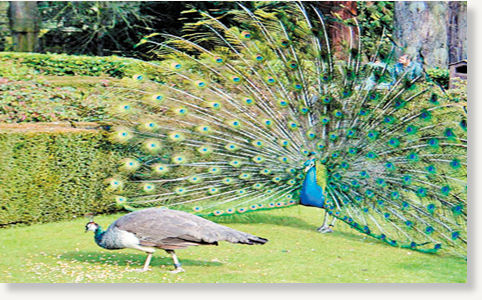
© Unknown
The mysterious death of two beautiful blue peacocks in their natural habitat, the Thar Desert, has caused concern among wildlife conservationists.
An official of Society for Conservation and Protection of Environment (Scope) in Mithi, Bharumal Amrani, has said that they have received reports of the death of two peacocks from different areas. He fears that more than 100 peacocks might have died in Mithi, Islamkot and Nagarparkar neighbourhoods.
The official is not sure about the places and the exact number of the birds that died, but says that Scope officials have made complains to Sindh Wildlife Department officials in their areas, but the officials have turned a deaf ear to the issue.
President Makhdoom Bilawal Welfare Society Arbab Nek Mohammad, who is supervising the project in collaboration with the UNDP Global Environment Facility's (GEF) Small Grants Programme, to conserve the peacocks in the Thar region, says that
according to the information their organisational network collected at least 500 peacocks have died so far. He said that a lack of feeding, especially grains, in the natural habitat and the biting cold in the area might be the main reasons behind the death of the birds.
He says that their organisation has developed 100 points for the peacocks in the Thar desert from Sanghar to Tharparkar districts in order to protect them. He fears that the remaining birds might not survive as no action has been taken so far by the authorities.
Local wildlife conservationists say that there could be multiple reasons for peacocks' deaths in Thar. Earlier, the village people used to fill water pots specifically to attract these birds, helping them in quenching their thirst, but now since the displacement of communities has become a routine, drought in some areas might be the reason behind the deaths. The other reason, they say, may be pesticides, which local farmers spray to kill insects to protect their vegetable and grain crops. Excessive use of pesticides may be the main reason because earlier there was no trend to use pests in rain-fed lands, according to the officials.
But Sindh Wildlife Department (SWD) officials disagree and identify a bacterial disease as the cause of the deaths. "It is not mystery. No viral infection is there in the entire region. The bird is safe," claims Hussain Bux Bhagat, ex-conservator of the Wildlife Department.
"Yes, the SWD received directives from Islamabad to submit a report regarding any mysterious disease in Thar, which might be causing the death of the beautiful birds. On these instructions, the SWD officials visited the area with teams and found that a peacock and peahen had died in two villages," Bhagat told The News. The teams linked the deaths to a bacterial disease, which is not harming other birds.
"I personally visited the area to observe the situation. I saw flocks of peacocks everywhere at sandy hills and traditional makeshift huts. It all happened after the recent monsoon rains. The impact of rain was positive, so we may see the peacock population increasing in the area," he said.
Tharparkar is one of the five famous eco-ranges of Pakistan. According to the 1997 survey of the SWD, Tharparkar is suitable to be declared as the National Park. The flora and fauna of Tharparkar, including peacock, Chinkara, deer, Neel bull, partridge, bustards, Gugural, Kandi, Kumbat, Phog and Rohiray, has been part of the folklore of Sindh.
There are 2,300 villages in the Tharparkar district, mostly along the remote sand dunes, and no accurate survey has been conducted to ascertain the population of peacocks in the area. People themselves are conservationists and protect the bird in their villages.
Reader Comments
to our Newsletter